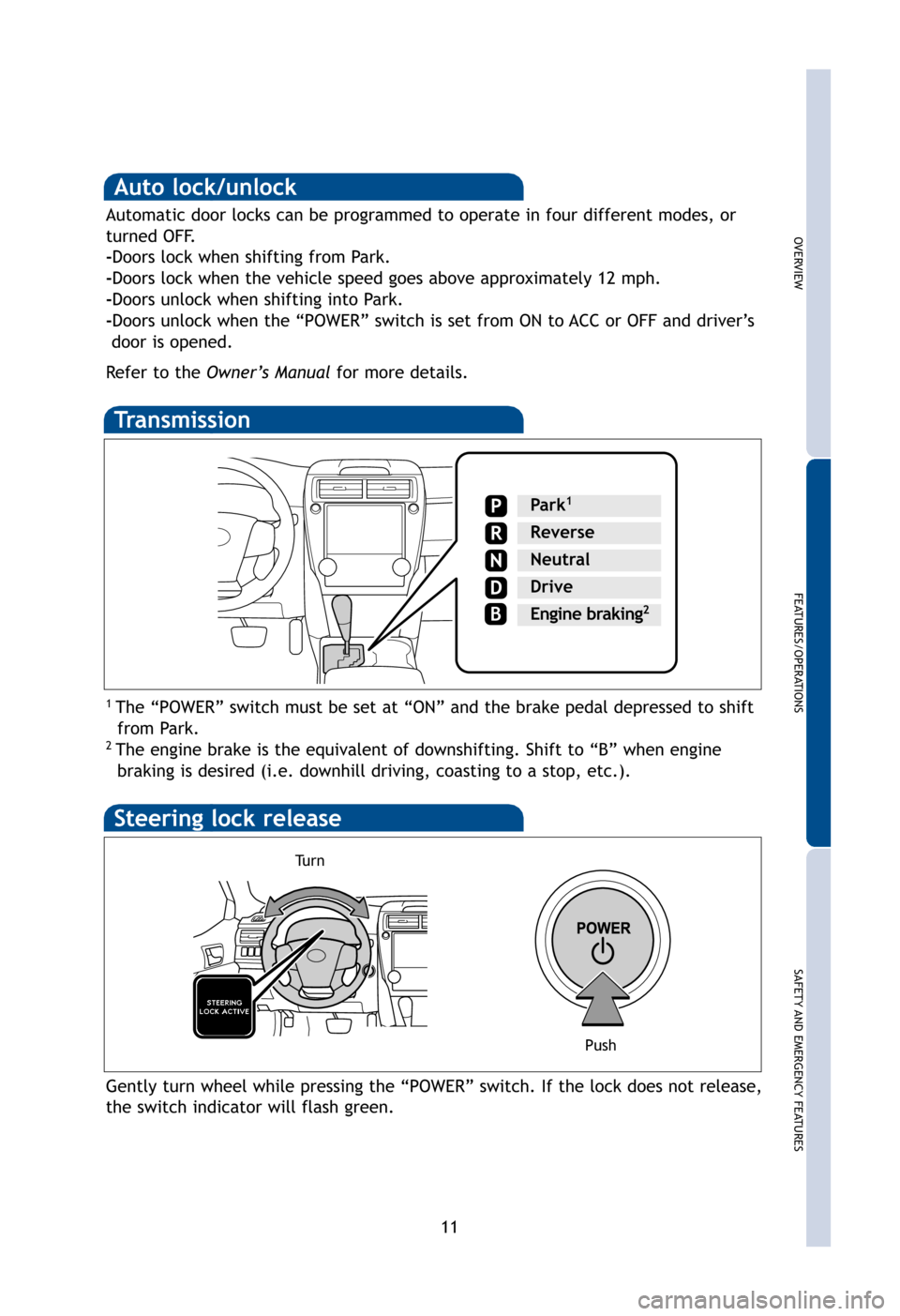four wheel drive TOYOTA CAMRY HYBRID 2012 XV50 / 9.G Quick Reference Guide
[x] Cancel search | Manufacturer: TOYOTA, Model Year: 2012, Model line: CAMRY HYBRID, Model: TOYOTA CAMRY HYBRID 2012 XV50 / 9.GPages: 31, PDF Size: 1.71 MB
Page 13 of 31

OVERVIEW
FEATURES/OPERATIONS
SAFETY AND EMERGENCYFEATURES
11
Transmission
1 The “POWER” switch must be set at “ON” and the brake pedal depr\
essed to shift
from Park.
2 The engine brake is the equivalent of downshifting. Shift to “B” when\
enginebraking is desired (i.e. downhill driving, coasting to a stop, etc.).
Park1
Reverse
Neutral
Drive
BEngine braking2
Steering lock release
Turn
Push
Auto lock/unlock
Automatic door locks can be programmed to operate in four different modes, or
turned OFF.
-Doors lock when shifting from Park.
-Doors lock when the vehicle speed goes above approximately 12 mph.
-Doors unlock when shifting into Park.
-Doors unlock when the “POWER” switch is set from ON to ACC or OFF and driver’s
door is opened.
Refer to the Owner’s Manual for more details.
tion
e
e
ual
.
hway.
Gently turn wheel while pressing the “POWER” switch. If the lock does no\
t release,
the switch indicator will flash green.
resize-camry.qxd 10/12/11 4:51 AM Page 11
Page 28 of 31

26
Star Safety SystemTM
VSC helps prevent loss of traction during cornering by reducing engine powe\
r and
applying brake force to selected wheels.
Toyota’s VSC monitors steering angle and the direction your vehicle is traveling\
.
When it senses that the front or rear wheels begin to lose traction, VSC red\
uces
engine power and applies braking to selected wheels. This helps restore traction
and vehicle control.
Vehicle Stability Control (VSC)
Anti-Lock Brake System (ABS)
Brake Assist (BA)
ABS helps prevent brakes from locking up by "pulsing" brake pressure to eac\
h
wheel. This limits brake lockup and provides the maximum brake effectiveness for
the current road conditions.
Toyota's ABS sensors detect which wheels are locking up and limits wheel lockup by
"pulsing" each wheel's brakes independently. Pulsing releases brake pressure
repeatedly for fractions of a second. This helps the tires attain the maximum
traction that the current road conditions will allow, helping you stay in control.
Brake Assist is designed to detect sudden or “panic” braking, and then add bra\
king
pressure to decrease the vehicle’s stopping distance. When there’s only a split
second to react, Brake Assist can add additional brake pressure more quickly than
just the driver alone can. VSC helps prevent loss of traction during cornering by reducing engine powe\
r, and
Traction Control helps maintain traction on loose gravel and wet, icy, or uneven
surfaces by applying brake force to the spinning wheel(s).
Toyota’s TRAC sensors are activated when one of the drive wheels starts to slip.
TRAC limits engine output and applies the brakes to the spinning wheel. This
transfers power to the wheels that still have traction to help you drive safely.
Traction Control (TRAC)
Electronic Brake Force Distribution (EBD)
Toyota’s ABS technology has Electronic Brake-force Distribution (EBD) to help
maintain stability and balance when braking. Abrupt stops cause the vehicle to tilt
forward, reducing the braking power of the rear wheels. EBD responds to sudden
stops by redistributing brake force to maximize the braking effectiveness of \
all
four wheels.
SAFETY AND EMERGENCYFEATURES
All new Toyota vehicles come standard with the Star Safety SystemTM, which
combines Vehicle Stability Control (VSC), Traction Control (TRAC), Anti-lock Braking
System (ABS), Electronic Brake-force Distribution (EBD), Brake Assist (BA) and Smart
Stop Technology (SST).
Ther
has m
For s
• O
•
Us pl
•In
Flo
Smar
and
SST
e
firml
SSTd
allow
back
Sma
resize-camry.qxd 10/12/11 4:59 AM Page 26